SAEDNEWS: Shahdad Kalut in Kerman is the world’s largest desert landform, a striking natural masterpiece shaped over thousands of years by wind, sand, and water.

Although a large part of the attractions of Kerman Province consists of historical monuments, one cannot ignore the natural wonders of this vast land; from the dense forests of Baft and Rabor to the tulip-covered heights of Bardsir, the Mediterranean-like Delfard Valley, and the Kehour forests. But the Shahdad Kaluts are among the natural marvels of Kerman Province; unforgettable formations that, when viewed from afar, resemble an ancient and abandoned city.
In the land of Shahdad Kaluts, a gentle breeze whispers in your ear, inviting you to witness the dignity of the Lut Desert. If you find yourself among the Kaluts at sunrise or sunset, it is impossible for anything other than admiration of this wonder to come to your mind. As the sun sets, the stars gradually appear, turning the dark expanse of the sky into the most beautiful image in the world. At night, one can become immersed in the sky above the city of Kaluts and gather clusters of stars. Standing atop these Kaluts, reality and imagination merge, time and space fade away, and a profound and unforgettable experience is created.
Let’s first practice a little geography and see what Klut and Barkhan are. Simply put, both are natural phenomena specific to desert areas. Barkhan is a phenomenon found in many deserts, but Klut exists only in certain deserts like Iran’s Lut Desert, and the deserts of the United States and Egypt. Klut is a Persian term formed from combining the words “Kal” and “Lut”; Kal means “city” and Lut refers to the Lut Desert. In geography, this phenomenon is called “yardang.”
From a distance, when approaching the Kharan Klut in Kerman, you might see what looks like a port! A large mirage where you imagine a ship could float, and buildings that seem to be where people live. But the sea ahead is only a mirage, and no one lives in these structures. If you leave the story to my imagination, I would say nature created these structures for the unknown creatures of the desert to inhabit.
A little further, the sands begin to dance to the tune of the swirling wind, and if such wind did not exist in the desert, it would be surprising. Walking on the sands, you feel the softness of the sand and want to sink your feet deeper. Depending on the time of day you choose to visit the Klut, you will feel either pleasant warmth or a chilling cold.
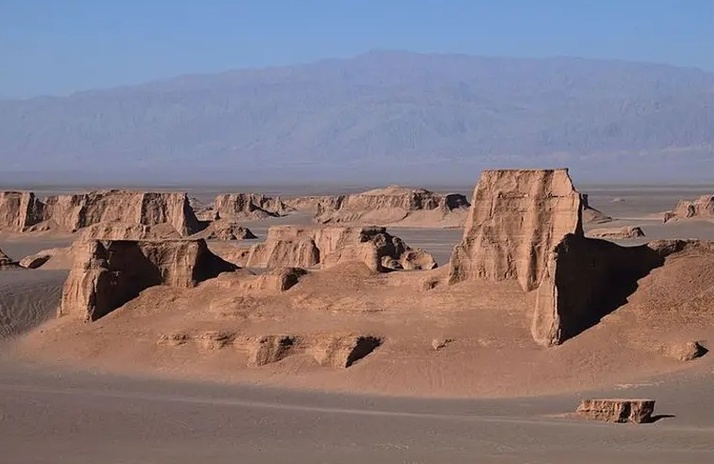
When you reach the Klut, you might think this area was designed by the architects of the Zand or Buyid dynasties. But after closer inspection, you realize that what you see is a masterpiece formed over thousands of years by wind, soil, and water. In desert environments, wind has tremendous power to erode rocks and shape them. The sand grains act like sandpaper that the wind has used to sculpt the rocks, creating the Klut structures.
Whenever you see desert dunes shaped in a way that you don’t want to disturb by walking or driving over them, you know you have reached a Barkhan! Barkhan is a type of sand dune where its slope is lower in the direction of the prevailing wind and higher on the opposite side. It is as if the wind, by shaping the sand on the dune, has created a platform to jump into the sky!
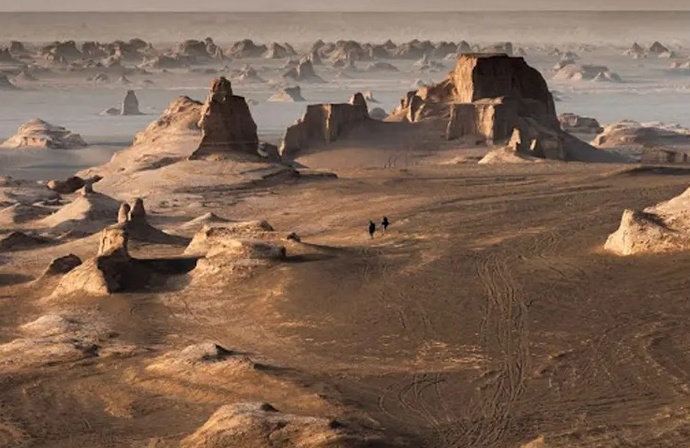
Barkhan sands are usually loose, and you must be very careful while walking or driving. Exploring the desert is a thrilling and sometimes frightening experience. However, if a guide accompanies you, you will never reach the dangerous parts, and all your memories of this dry natural attraction will be full of enjoyment and excitement.
Kluts exist in some of the world’s large deserts, but none are as large as the Kharan Klut in Kerman. Kharan Klut resembles the capital of an ancient civilization. A civilization where no one lives now, and when walking among it, you hear nothing except the wind howling through the “skyscrapers” of the city made of clay. Kharan Klut is a little frightening, and if you let your imagination run wild about this area, it will make your hair stand on end!

Kharan Klut, Kerman, is a land 145 kilometers long and 40 kilometers wide, and throughout its area, wind-sculpted structures can be seen. However, no one has fully explored the mysteries of the Klut so far, and it remains a mysterious and enigmatic land. Perhaps somewhere within the Klut a well might appear, or a site where a large meteorite struck the ground exists, or even the bones of a dinosaur might be buried somewhere. The vastness of the Lut Desert is such that it can hide many stories within its heart.

The temperature of Shahdad Kalut is extremely high and it is recognized as one of the heat poles of the Earth, with temperatures reaching 70°C. In this area, there is an unequal struggle between life and death; the salty water and soil and the temperature of Shahdad Kalut in Kerman erase every sign of life!
It is narrated that in 1986, a cow died in this region, and 15 years later, desert travelers found its body intact and dried. This means that even scavengers cannot survive around here. However, humans are travelers of this terrifying and unknown land and leave traces of life in this area!
In Shahdad Kalut, traces of metal and human life have been found, telling a terrifying and sorrowful story. A story that, if you sit by a fire in the desert one night and listen to it, will make you shiver. Archaeologists have discovered human-made artifacts and metal objects in this area, indicating that humans once lived here.
Archaeologists say that the age of these discovered items dates back four to five thousand years. Since they were found among sand and salt, it is understood that this land was habitable before the formation of the Kalut.
The likely story is that in a great flood, life and civilization in this region were destroyed, and now nothing remains but soil and sand. Perhaps somewhere deep within the sands of the Kalut, traces of ancient civilization can be seen, and the Kalut formations are a memorial that nature built for that civilization under the soil! One of the reasons this area was named Kalut (meaning “City of Lut” or “a city in Lut”) is this relatively true legend.
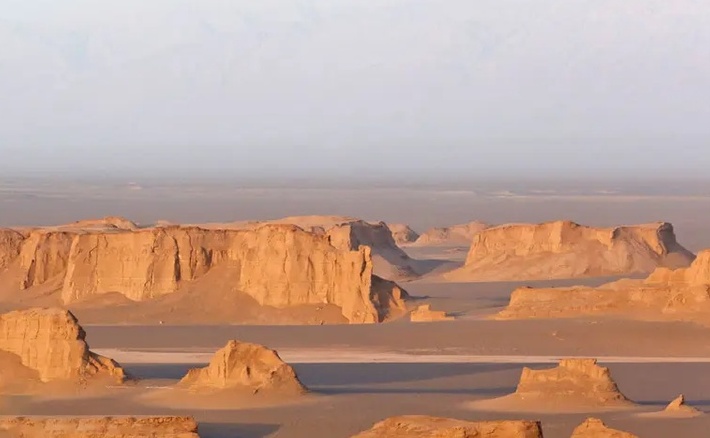
Nature has not stopped its architecture in Shahdad Kalut, Kerman, and continues to reshape the appearance of ancient rocks and sand dunes with the help of the Shour River and the 120-day winds blowing from Sistan. If you saw the Kalut a few years ago and visit it again this year, probably none of the rocks will look like what you saw before.
The Shour River flows through the heart of the Lut Desert and keeps the Kalut towers and walls moist; the wind also scratches the wet rocks with its sandy files. Wet rocks are more easily eroded, creating an unparalleled collaboration between water, wind, and soil.
This area is the largest yardang phenomenon in the world and the hottest spot on Earth, so it is no surprise that its name, in addition to being on the list of Iran’s Cultural Heritage Organization, has also been registered by UNESCO.
Exploring nature, especially desert and arid regions, is the riskiest type of tourism, but the beauty of this area is so remarkable that it cannot be ignored! One of the measures to guide tourists and prevent possible damage from desert trekking is to divide this area into green, orange, and red zones.
The green zone of the Kalut is an area that does not require professional desert trekking, and everyone can visit it. Two kilometers of the Shahdad-Nehbandan road belong to the green zone, and tourists generally visit this area. All recreational facilities of Shahdad Kalut in Kerman are within the green zone. At first glance, you might think that in a two-kilometer distance you cannot see the rocks and Kalut towers, but the towers begin at the very start of the zone, and these two kilometers are sufficient to understand the grandeur and majesty of this mysterious land.
Visiting the orange and red zones requires desert trekking skills, professional equipment including a suitable vehicle, and a guide. In the red zone, the importance of skills and equipment increases, and even experienced desert travelers may be at risk. The Environmental Organization has marked part of the area red to prevent desert travelers from joining the buried civilization of Shahdad Kalut, and only special individuals are allowed to enter it.
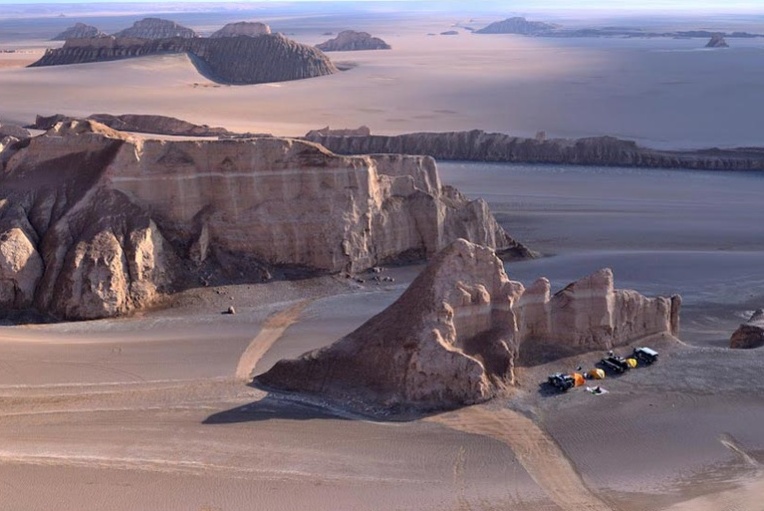
In the Shahdad Desert, a river flows for 200 kilometers. When this river originates from the Birjand Mountains, it has fresh water, but as it passes through the sand and salt of the Lut Desert, a large amount of salt dissolves in it. This river is among the saltiest waters in the world, making it practically undrinkable for living creatures and unusable for plants.
The salinity of the river reflects the high percentage of salt in the sands and rocks of this desert. The ground cover in most parts of the area is sand, and due to the presence of the salty river, if you dig your hand into it, you feel a bit of moisture and the sand sticks to your hand. Of course, the moisture level of the ground also depends on its distance from the river. In some areas, the amount of salt in the soil increases, and instead of soft sand, you see salt flats where salt rocks have unique shapes such as sugarloaf, eggs, and more.
No one expects water to exist in the heart of the desert, which is why tourists are amazed when they see the Shahdad Salt Lake. The water of this lake is so salty that in some parts of the shore, the salt precipitates and creates beautiful salt patterns. Everything in this lake is salt-borne!
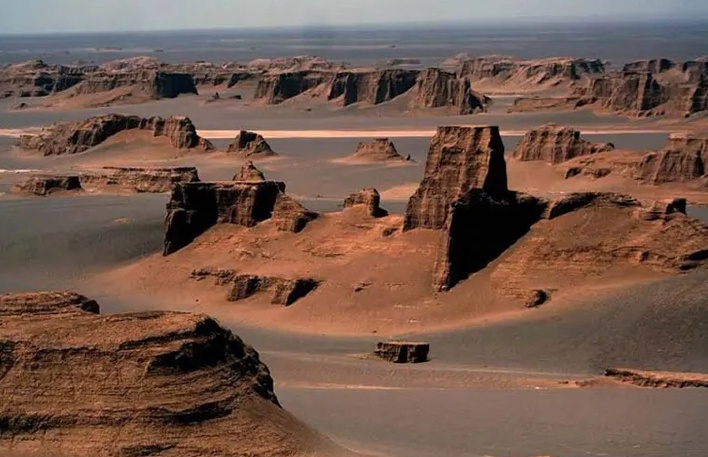
Life is a foreign concept for the Shahdad Kaluts; the Shahdad camping site is the last point where living is possible. Of course, the presence of travelers and tourists in this area gives meaning to life. Shahdad is only hospitable for a few days, and then the salty water and temperature of the Shahdad Kaluts invite you to return home!
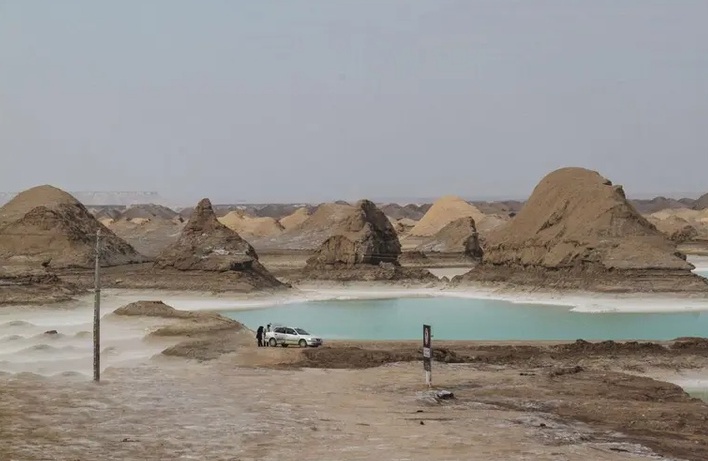
On the path toward the Kaluts, in the initial parts of Shahdad Kaluts, vegetation can be seen. In some places, traces of ancient floods that destroyed houses are visible, and along this path, there are Tamarisk shrubs. Astragalus bushes are other resilient plants adapted to the harshness of the desert. But when you reach the inner area of the Kaluts, vegetation disappears. It seems that plants are also aware of the dangers of the orange and red zones of Shahdad and do not enter them!
The desert is a lifeless attraction, and the Shahdad Kaluts in Kerman have as many sights as the days it hosts you. Walking in this area is a pleasant pastime because the soft sand caresses your feet. If you want to sink your feet deeper, be careful of insects that live in the sand.
Walking should be done before sunrise or after sunset. When the sun is high in the sky, the ground and air become so hot that not only do you not enjoy the sights of Kerman and Shahdad Kaluts, but you may even forget why you came on this trip! But if the sun shines a little more gently, there are many sights and sounds to experience in the Shahdad Kaluts.

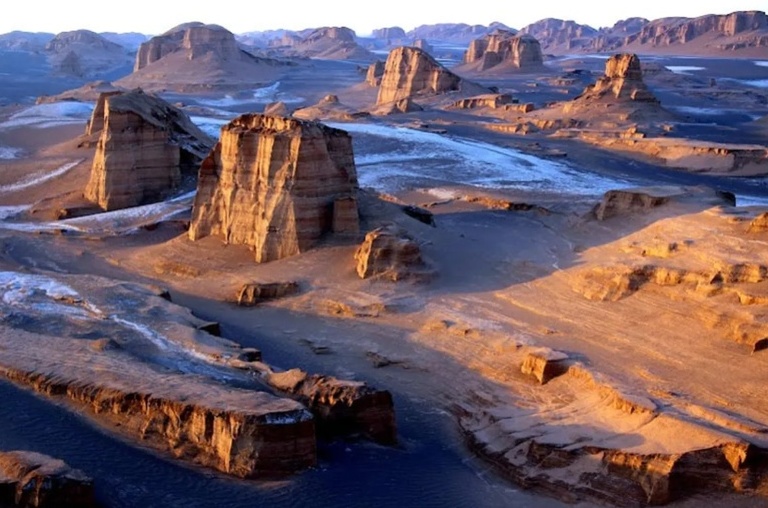
The salty river originates from the Birjand Mountains and ends in a place called the Salt Mine Basin. This river flows throughout the year, but it is so salty that no living creature can use it. Being in this area gives the impression that you have entered a planet with water and soil, but due to extreme salinity, humans cannot live there. The salty river of Shahdad Kaluts, Kerman, has turned the area into a watery Mars.
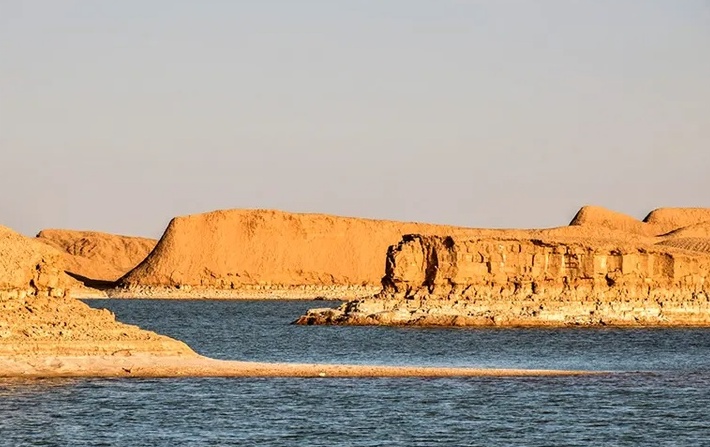
In previous sections, I talked about wind and water salt formations in this region. Salt deposits that take the shape of hexagons are called polygons. These deposits are mostly seen around the lake and are one of the natural attractions of the Shahdad Kalut in Kerman. Of course, you might also see this phenomenon in the surrounding salt flats. Polygons are nature’s geometric masterpieces and remind me of a beehive on the ground.
When I was approaching Kalut from a distance, I saw many mirages, so when Javan Lake of Shahdad Kalut appeared from afar, I thought it was a mirage! But as we got a little closer, I realized that when there is water in the hottest place on Earth, nothing is impossible!
Javan Lake is a unique attraction in Shahdad Kalut, Kerman, with both great size and breathtaking views. Salt has deposited on the shores of the lake, and combined with the polygons, it creates an unparalleled natural scene. You can stop for a while beside the lake along the Shahdad Kalut off-road path and move from excitement toward tranquility.
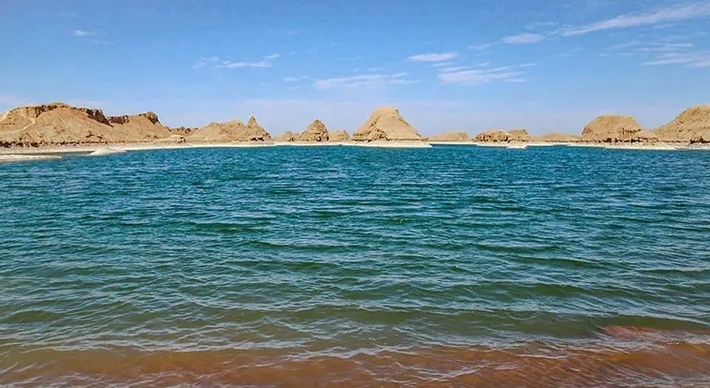
In traditional medicine, foot washing with salt is highly recommended because it relieves fatigue and gives a feeling of lightness. Now imagine a salty path where you can walk and revive your feet. After all, the feet are our second heart and need rest and care.
Shahdad’s salt flats are not very different from other salt flats in Iran; the only difference is that while walking, you can admire the clod and soil towers of Shahdad Kalut, Kerman. The scenery around Shahdad’s salt flats is distinct from what you see in other saltlands.
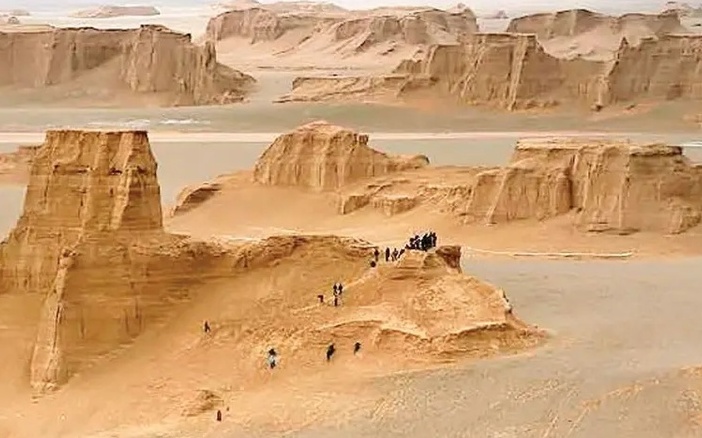
Nebka is the natural gardening and flower-making effect in Shahdad Kalut, Kerman! When you see them, you imagine someone has made a pot with sand and planted small tamarisk trees in it. As mentioned, in the initial part of Shahdad Kalut, there is vegetation, and in this area, the nebkas can also be seen. Some of these nebkas are very tall and appear like giant pots. The wonders of the Lut Desert are so remarkable that you might imagine all mythical creatures from movies and books live here and have left traces of themselves!
By now, you are probably convinced that Shahdad Kalut in Kerman has many attractions and is a must-see, but we have just reached the exciting parts of desert exploration in this area. Besides walking on sands and salt flats and seeing rivers and lakes, there are even more thrilling activities you can do. Activities that will make your eyes sparkle with excitement and your hands clench in enthusiasm!

The attractions of Kalut are not limited to the land; the sky also holds many sparkling diamonds and jewels. The night sky shows that nature is well-versed in the art of jewelry-making and knows how to carve and arrange stars to leave people astonished!
If you spend the night in Shahdad Kalut, Kerman, you will probably not be able to take your eyes off the sky, discovering something new in this flawless jeweled canvas at every moment. You’ll want to connect the stars to each other and create new shapes. Seeing the desert night sky of this area awakens the astronomer within you, and you may wish to join astronomy or astrophotography courses after returning from the trip.
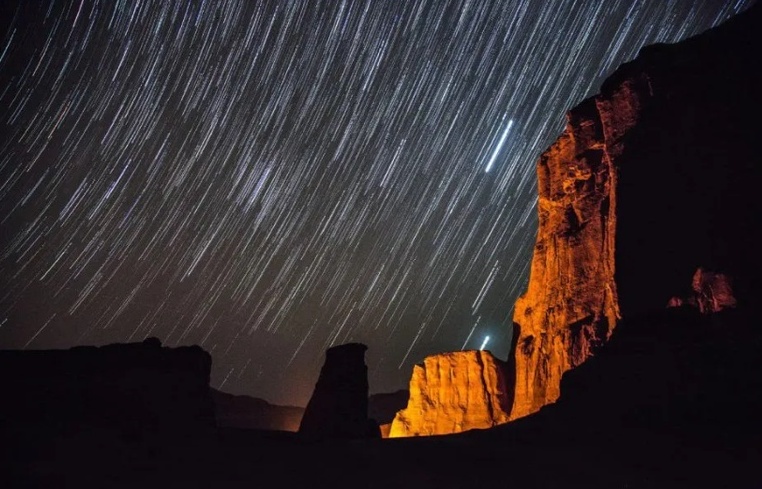
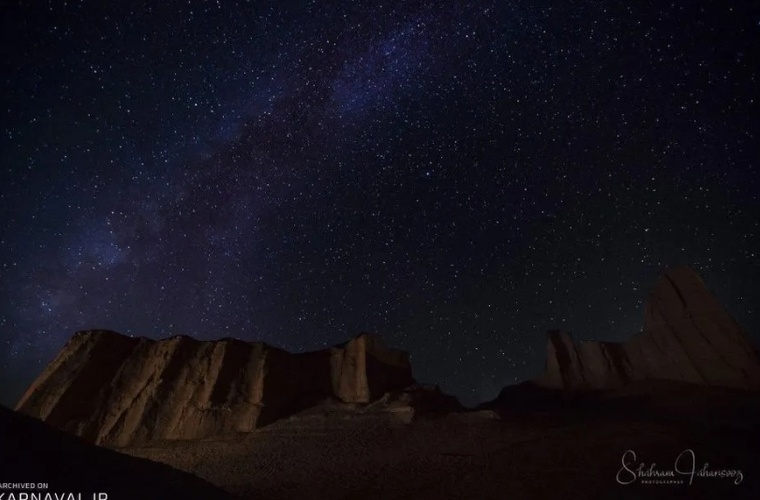
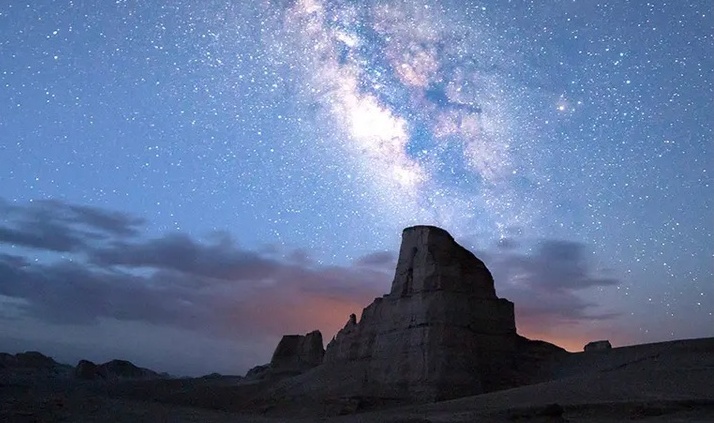
Many researchers and people active in the field of astronomy spend the night in the Lut Desert and take photos unlike anywhere else in the world. The feast is complete when an astronomical event such as a meteor shower or the passage of a comet also occurs on the same night and you witness it. By spending the night in the Shahdad Kaluts of Kerman, you realize that the night sky of the hottest point on Earth is just as breathtaking as the night sky of the coldest places with the aurora borealis.
Living for a few hours in the style of Bedouin Arabs in the Shahdad Kaluts of Kerman is an interesting experience. Traveling by camel, drinking camel’s milk, and staying in tents or buildings made with natural desert materials takes you back a thousand years, to a time when Arabs lived in this way.
Camel riding is a tough but fascinating experience. If you mount the camel while it is getting up, you will feel every moment as if you are about to fall, and indeed, if you don’t listen to the camel driver, that’s exactly what will happen! If the camel is already standing, you must climb onto a stool first and then get on. In my opinion, the camel is the most difficult means of transport to mount!
After that, things get better, because the camel is one of the slowest animals used by humans for transportation. The animal slowly steps on the sands of the Shahdad Kaluts of Kerman, while the sound of the wind and the camel’s bell resonates in your ears. The wind moves the twigs, debris, and sands of the desert.
To prevent the sun from burning your skin, you should tie a turban or keffiyeh on your head, leaving nothing visible except your eyes. Probably in such conditions, you will expect someone from afar to gallop toward you on a horse bringing you a letter, so that everything looks exactly like the movies you have seen from that era.
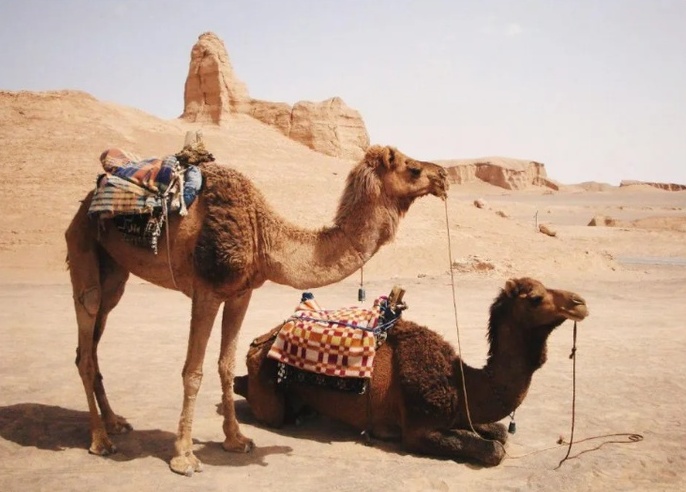
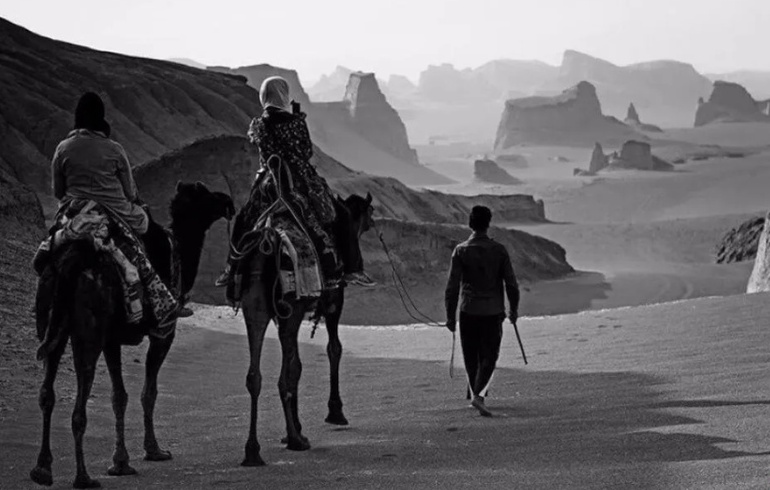
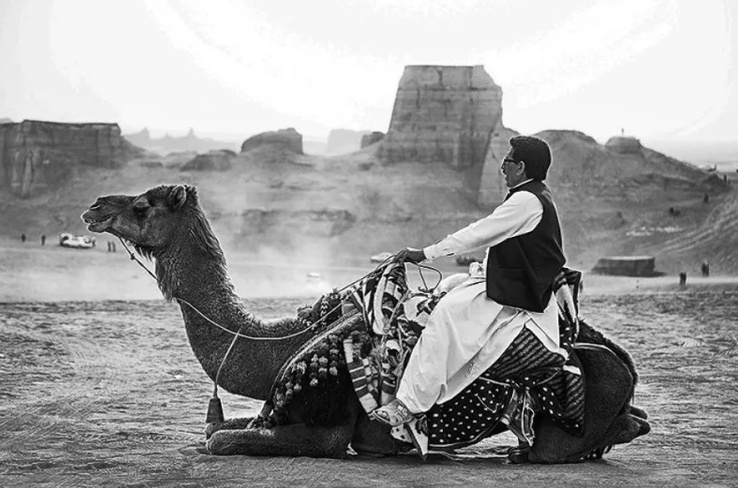
The quad bike in Kalut Shahdad, Kerman, represents a balanced experience: it is neither as slow as a camel nor as thrilling as a safari. Of course, this also depends on you. Some people like to experience high excitement with a quad bike, and for that reason, they head toward the sand dunes and slopes!
These vehicles are rented by the hour and do not require a driver. By following safety instructions, you can drive them yourself. It is better to wear clothing that prevents sand from entering; otherwise, you will spend hours removing sand from your clothes.
Since quad bikes have no roof or walls, you will feel every uphill and slope you pass with your entire being. You bounce up and down over every bump, and after each dune, you may have a small jump. If you have never had an experience similar to a quad bike, it is better to drive safely and at a moderate speed.
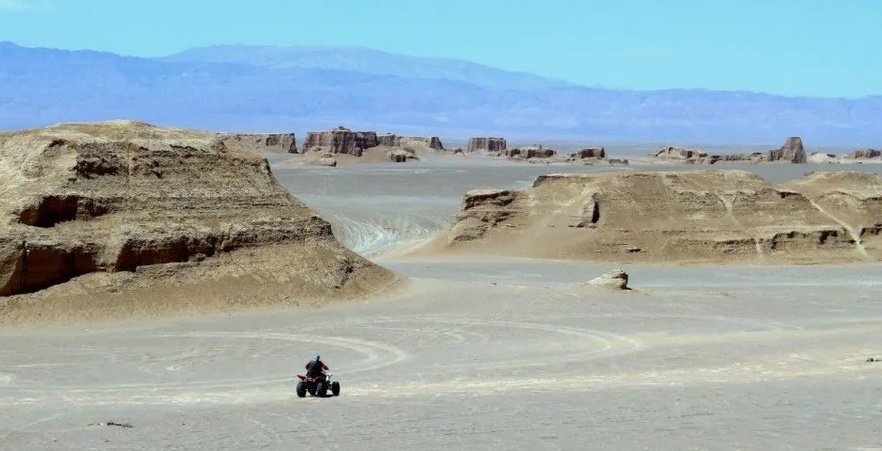
Now that you have experienced the lifestyle of the ancient nomads, let’s move on to the modern nomads and their thrilling way of life. If you are not into excitement and have no interest in being scared, adrenaline rushes, and a racing heartbeat, it’s better to skip this activity.
Safari in the Shahdad Kaluts of Kerman is an indescribable adventure, like a dessert you cannot understand unless you taste it yourself! At the Kalut camp, off-road vehicles are rented by the hour, and if you don’t have experience driving in the desert, a driver will accompany you.
The fun begins the moment you feel like you’re sinking into the sand and the car cannot move forward anymore; eventually, it reaches the point where a massive whirlwind of sand is rising behind you, you’re on a steep slope, and you feel like the car is about to flip and land upside down at any moment!
The good news is that you neither overturn nor sink into the sand, because the area is safe for safari with a professional driver. In my opinion, the brain just creates these thoughts one after another to heighten the thrill!
In short, when you step out of the safari vehicle, your voice is probably gone, because you’re free to scream as much as you like and release your excitement in any way you want. Of course, you’ll probably look like someone who has just escaped a storm: covered in sand, messy hair, and a dazed, bewildered face!
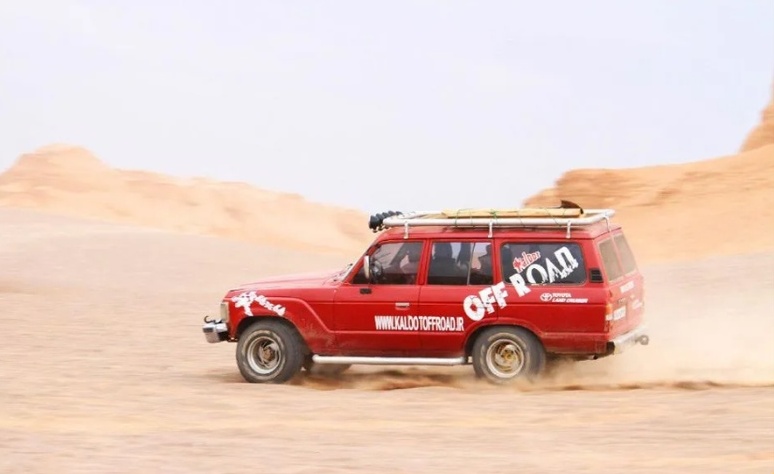
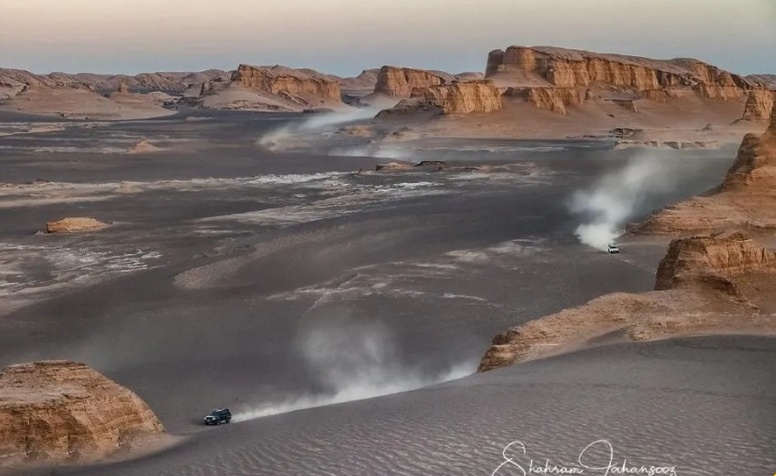
There is nothing more pleasant than the words of a friend! Cameras and photography are a traveler's best companions, and it is almost impossible to travel somewhere without taking photos. Visiting Kalut Shahdad in Kerman will probably provide you with photos for your profile for a whole year. If you enjoy printing photos and the joy of flipping through albums, one of your most memorable albums will be from your desert trip to Kalut Shahdad.
In the Shahdad Desert, you can sit on the sand, stand along the sun, throw sand into the air (be careful with your eyes), and jump and take photos with your friends. The desert is a popular photography location for both solo and group photos.
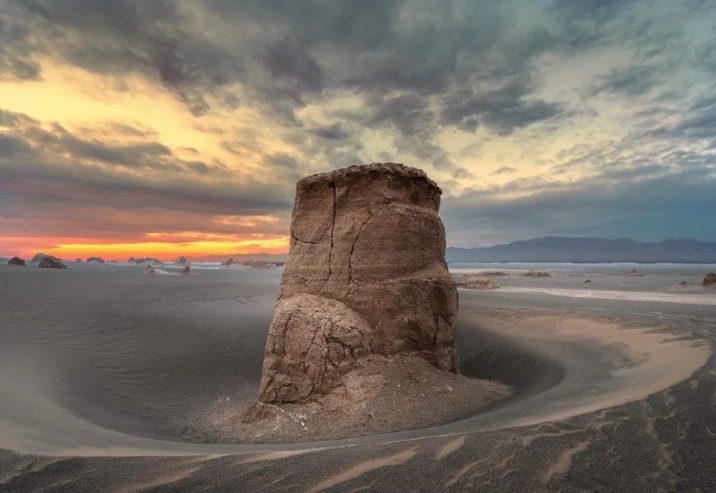
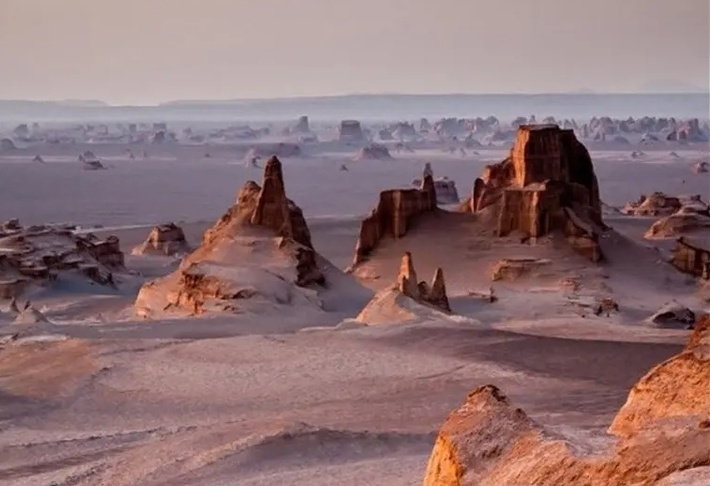
Even if you do not intend to enter the orange and red zones and stay in the green area, you must still have the necessary equipment for desert touring and recreation. Below are the most important points to pay attention to when desert trekking:
Do not enter the orange and red zones without a permit and without a guide familiar with the area.
The best way to visit Kalut Shahdad is by joining a tourist tour.
Bring appropriate clothing and shoes that sand cannot penetrate. Do not forget a sun hat or scarf.
Bring sunglasses, sunscreen, and essential personal items.
Buy everything you need from the city; there are not many shopping facilities in Kalut.
Watch out for stinging creatures. They may rest during the day under the shade of dunes or bushes, and if you approach them, they may sting.
In case of a sting, make sure to get help from a rescuer. If no one is available, block the blood flow with a tied cloth so the venom does not enter the bloodstream. Suck the sting site.
If you plan to stay outside the Kalut Shahdad camp overnight, make sure to accompany professional desert trekkers.
Do not pollute Kalut by shouting, making large fires, or leaving trash behind. The best tourists leave no trace after their departure.
Be prepared for loss of signal and internet, and inform your loved ones in advance how long you will be in Kalut.
The temperature in Kalut Shahdad, Kerman, during the hot seasons starting from mid-May until late September is so high that no tours are held in the area. The best time to visit Kalut Shahdad is during the cooler seasons, from autumn and winter to spring.
If you want to visit when there are not many people, it is better to plan for non-holiday days. For example, during Nowruz and the days near it, the number of travelers to Kerman is high, and most of them include a visit to Kalut Shahdad in their itinerary.
In the past, visiting the Shahdad Kaluts was not possible for the general public, and only professional individuals could obtain a permit to enter this area. The beauty of this region was so remarkable that it could not be left out of the list of Kerman’s tourist attractions, which prompted the authorities to take action. The best solution, which was eventually implemented, was to color-code the areas of the Shahdad Kaluts.
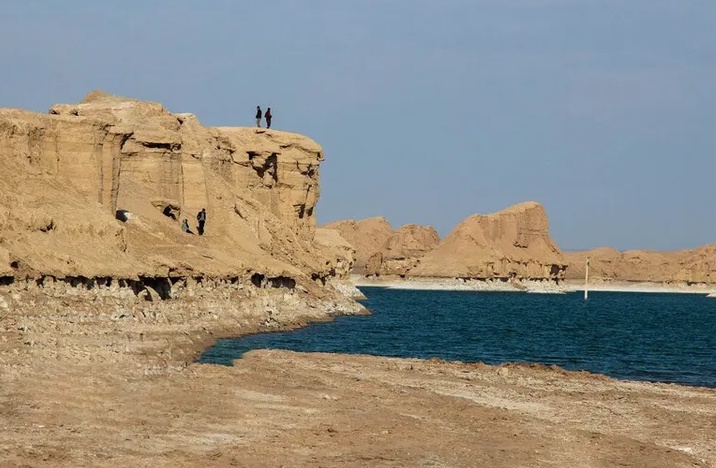
In the green zone of the Shahdad Kaluts of Kerman, there are welfare, recreational, and even accommodation facilities, and everyone can visit it; everything mentioned in this article refers to the green zone of the Shahdad Kaluts. Professional desert explorers who wish to venture further into the Kaluts and enter the orange and red zones must obtain a permit from the Environmental Protection Organization.
To issue this permit, it is assessed whether the group members have the necessary skills for navigation and desert trekking. The equipment and facilities they use for desert exploration are also evaluated.
The Shahdad Kaluts are located near a city of the same name. The height of these Kaluts is 430 meters above sea level, and the distance from the Lut Desert plain is 30 kilometers. This area is near the Takab plain and a massive sand mound in the eastern part of the desert.

